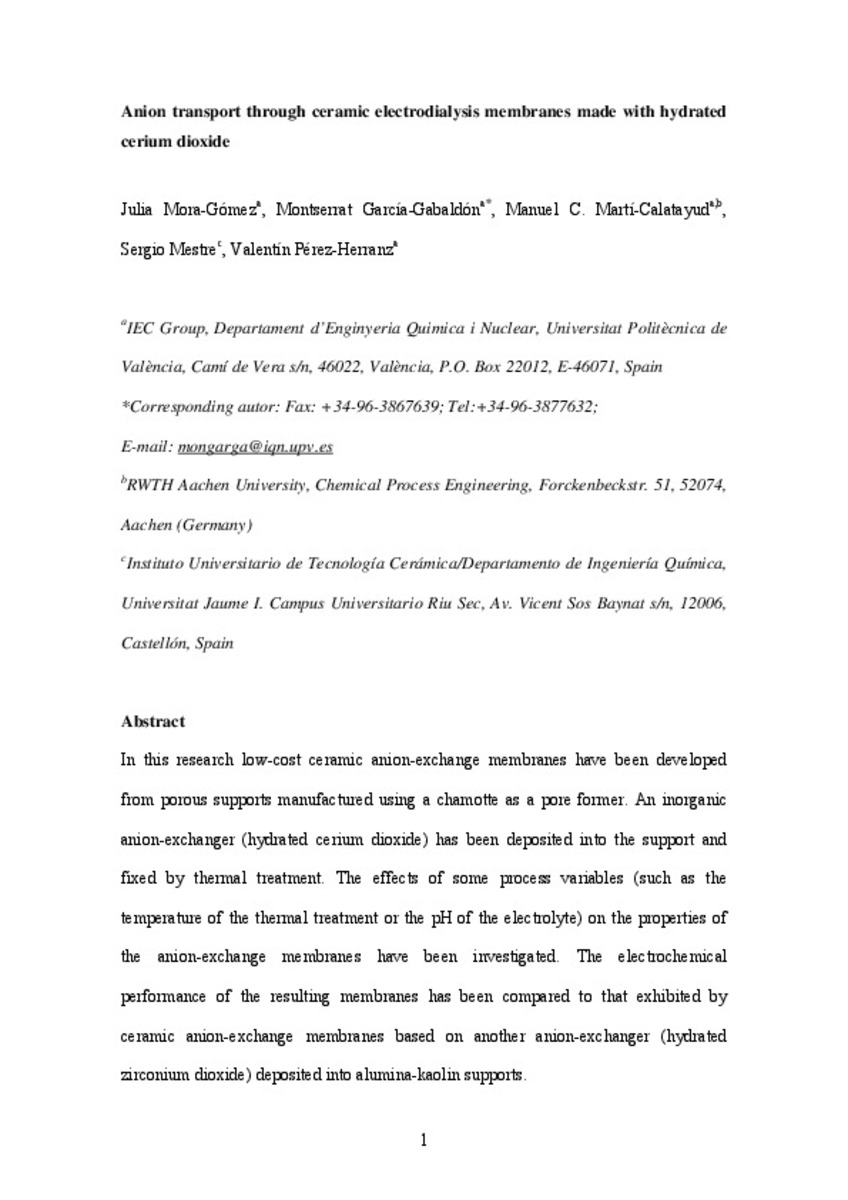Mostrar el registro sencillo del ítem
Anion transport through ceramic electrodialysis membranes made with hydrated cerium dioxide
| dc.contributor.author | Mora Gómez, Julia | |
| dc.contributor.author | García Gabaldón, Montserrat | |
| dc.contributor.author | Martí Calatayud, Manuel César | |
| dc.contributor.author | Mestre Beltrán, Sergio | |
| dc.contributor.author | Pérez-Herranz, Valentín | |
| dc.date.accessioned | 2017-12-13T11:13:14Z | |
| dc.date.available | 2017-12-13T11:13:14Z | |
| dc.date.issued | 2017-05 | |
| dc.identifier.citation | Mora-Gómez J, García-Gabaldón M, Martí-Calatayud MC, Mestre S, Pérez-Herranz V. Anion transport through ceramic electrodialysis membranes made with hydrated cerium dioxide. J Am Ceram Soc. 2017;100:4180–4189. https://doi.org/10.1111/jace.14978 | ca_CA |
| dc.identifier.uri | http://hdl.handle.net/10234/170811 | |
| dc.description.abstract | In this research, low-cost ceramic anion-exchange membranes have been developed from porous supports manufactured, using a chamotte as a pore former. An inorganic anion-exchanger (hydrated cerium dioxide) has been deposited into the support and fixed by thermal treatment. The effects of some process variables (such as the temperature of the thermal treatment or the pH of the electrolyte) on the properties of the anion-exchange membranes have been investigated. The electrochemical performance of the resulting membranes has been compared to that exhibited by ceramic anion-exchange membranes based on another anion exchanger (hydrated zirconium dioxide) deposited into alumina-kaolin supports. The temperature of the thermal treatment applied to fix the hydrated cerium dioxide (HCeD) does not affect the structure nor the electrochemical properties of the membranes. The porosity of the supports obtained, using a chamotte as the pore former was lower than that of the alumina-kaolin ones, which led to a lower deposition of hydrated cerium dioxide than that obtained for hydrated zirconium dioxide (HZrD) in alumina-kaolin supports. The higher porosity registered for the HZrD-based membrane also implies higher membrane conductivities. The selective transport of anions through the membranes was enhanced by increasing the number of infiltrating steps, as confirmed from current to voltage curves. However, this behavior was only apparent at acidic or neutral pH, thus confirming the amphoteric character of the anion-exchanger. Comparing the γ parameter (equivalents of ion exchanger per gram of deposited oxide), it is concluded that the porosity of the ceramic supports, consequence of their distinct microstructure, is the main parameter responsible for the difference in the ion-exchange capacity obtained for HZrD and HCeD membranes. Consequently, the CeO2 particles used in this work are also good candidates to impart ion-exchange properties to microporous ceramic supports. | ca_CA |
| dc.format.extent | 9 p. | ca_CA |
| dc.format.mimetype | application/pdf | ca_CA |
| dc.language.iso | eng | ca_CA |
| dc.publisher | Wiley | ca_CA |
| dc.rights | Copyright © 1999 - 2017 John Wiley & Sons, Inc. All Rights Reserved | ca_CA |
| dc.rights.uri | http://rightsstatements.org/vocab/InC/1.0/ | * |
| dc.subject | ceramic anion-exchange membranes | ca_CA |
| dc.subject | chronopotentiometry | ca_CA |
| dc.subject | hydrated cerium dioxide | ca_CA |
| dc.subject | ion-exchange capacity | ca_CA |
| dc.title | Anion transport through ceramic electrodialysis membranes made with hydrated cerium dioxide | ca_CA |
| dc.type | info:eu-repo/semantics/article | ca_CA |
| dc.identifier.doi | http://dx.doi.org/10.1111/jace.14978 | |
| dc.relation.projectID | Ministerio de Economía y Competitividad (Spain) (project number CTQ2012-3750-C02-01/PPQ and CTQ2012-3750-C02- 02/PPQ) | ca_CA |
| dc.rights.accessRights | info:eu-repo/semantics/openAccess | ca_CA |
| dc.relation.publisherVersion | http://onlinelibrary.wiley.com/doi/10.1111/jace.14978/full | ca_CA |
| dc.type.version | info:eu-repo/semantics/draft | ca_CA |
Ficheros en el ítem
Este ítem aparece en la(s) siguiente(s) colección(ones)
-
QUI_Articles [296]







